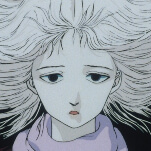If you want a licensed property taken in a bold new direction on the comics page, cartoonist Tom Scioli is the person to seek out. Scioli’s Transformers Vs. G.I. Joe series established him as a creator who knows how to use established concepts in strange and unpredictable new ways, combining the mythology and characters of the two title properties into a sprawling epic that constantly experimented with pacing, layout, and narrative structure. The crossover was co-written by John Barber, a veteran of IDW’s Transformers comics, but it was Scioli’s book, and he was responsible for the art, colors, and letters in addition to playing a leading role in the scripting.
Transformers Vs. G.I. Joe is a comic book that takes full advantage of storytelling tricks that are only possible in comics, which makes it impossible to create a faithful movie adaptation. For example, Transformers Vs. G.I. Joe #5 opens with a two-page spread of Cybertron’s surface, overlaid with panels pointing to specific areas, providing quick glimpses of what nearly every cast member is doing in their location. That one image gives readers a huge amount of information, and there’s no way to replicate that on the screen. Then there are the multiple moments when Scioli jumps to comic-strip-style tangents for different characters, condensing scenes into a few panels that effectively switch up the pacing and provide a break from the main action to deliver exposition or set up future plot points.
Even without the formal experimentation, a movie adaptation of Transformers Vs. G.I. Joe would be ridiculously expensive, especially if it were done the way Scioli describes in this week’s one-shot. In a fake news item describing the movie’s revolutionary special effects, Scioli writes about how the ideal adaptation of this work would primarily involve practical special effects, with computers being used to design the costumes and sets but most everything being made with real materials. Sets are built with artificial scale, and the G.I. Joe actors stand far away from the camera while the Transformers stand close, an old-school special-effects technique used in movies like Attack Of The 50 Foot Woman. The news items, which also include two interviews with the actors playing Scarlett and Optimus Prime, are spot-on satires of promotional industry articles, and they show how much thought Scioli has put into the world surrounding the movie adaptation.
Scioli has a significant challenge in condensing the 300-plus-page Transformers Vs. G.I. Joe miniseries into 20 pages for the comic-book movie adaptation. A massive amount is cut for the movie, and the story that remains is stripped down even further for the comic, leaving readers with a frantically paced summary of the major events in the movie. This is a common occurrence in comic-book adaptations of real films, and comic creators have to pick major moments to spotlight and abandon the less integral material. The comic-book adaptation of the Transformers Vs. G.I. Joe movie is a very quick read, but it’s not unsatisfying. Given how dense the miniseries issues were, it’s interesting to see Scioli switch gears for this adaptation and take a more conventional approach to the story.
Transformers Vs. G.I. Joe #9 featured an issue-long flashback to Vikings discovering an Autobot ship on Earth centuries ago, but in the adaptation, that story is boiled down to a dramatically narrated single-page prologue. That’s immediately followed by a montage of Scarlett in G.I. Joe training, and the majority of the story focuses on Scarlett and her silent love interest, Snake Eyes, who provides narration via the letter he is writing to his sister. The script has an overblown quality that pokes fun at the dialogue in action blockbusters, and one of the issue’s funniest moments is when Scarlett asks Optimus Prime, “But is there a Cybertronian word for… ‘love’?” The answer comes courtesy of Snake Eyes’ written narration as Scarlett and Optimus are caught in an explosion: “There’s no room for love on a planet built only for war.”
The artwork in this week’s adaptation is also much more straightforward, replicating the wide-screen look of a theater screen. There’s much less variety in the layouts, a commentary on how movie adaptations lose much of the visual character of the comics they are based on. There’s still plenty of energy—the Kirby influence ensures that Scioli’s art will never be lethargic—but Scioli isn’t as interested in innovating with this one-shot. He’s more concerned with using the clichés of the action movie genre, like a slow-motion shot of the heroes strutting into battle or a final-act twist that sets up a sequel. It makes for a fascinating exploration of the differences between cinematic and comic-book storytelling, and the concessions that have to be made in order to bring a comic to the screen.
Scioli sketched out the entire movie adaptation in the summer of 2014, just after the first issue of the original miniseries was released, and he knew from the start that this was going to be a much more basic story firmly rooted in the conventions of action blockbusters. All of Scioli’s original sketches are included in this week’s release, along with director’s commentary from Scioli and the aforementioned fake news items. This issue stands on its own, but I wouldn’t recommend this as an introduction to Transformers Vs. G.I. Joe. The entire miniseries is currently available in three volumes, which include commentary for every issue, and later this year, IDW is collecting everything in one big hardcover that is sure to be a must-have for fans of both properties.
Readers craving more of Scioli’s work on a monthly basis can find it in the pages of Young Animal’s Cave Carson Has A Cybernetic Eye, which features a “Super Powers” backup that allows Scioli to do whatever the hell he wants with DC Comics characters and concepts. “Super Powers” is one of the best things in superhero comics every single month, and each three-page backup has more ambition and ingenuity than the vast majority of superhero titles. Scioli’s Wonder Twins strips appear in every “Super Powers” backup, and reimagining the Super Friends siblings as aliens from a planet that is aesthetically and culturally based on Victorian England is the exact kind of bizarre twist that readers can rely on Scioli to consistently deliver.
The origin for Scioli’s Green Arrow begins with wealthy playboy Oliver Queen getting stranded on an island, but then veers wildly from tradition by having the island be a giant Starro elder god, which turns Oliver into the agent of Dimension Xero’s Xeen Arrow. Last week’s “Super Powers” featured DC heroes, including Jack Kirby’s New Gods, teaming up against an alien contagion, and ended with the group realizing it was facing an even greater enemy: the reader holding the comic. “Super Powers” gives Scioli the opportunity to put his distinct stamp on over 80 years of superhero mythology, and every installment brings new surprises. Scioli’s exhilarating work with licensed IP shows the value of giving creators the freedom to bring their specific vision to established ideas, and publishers should put these properties in the hands of more creators with strong perspectives who are willing to take bold risks.








































